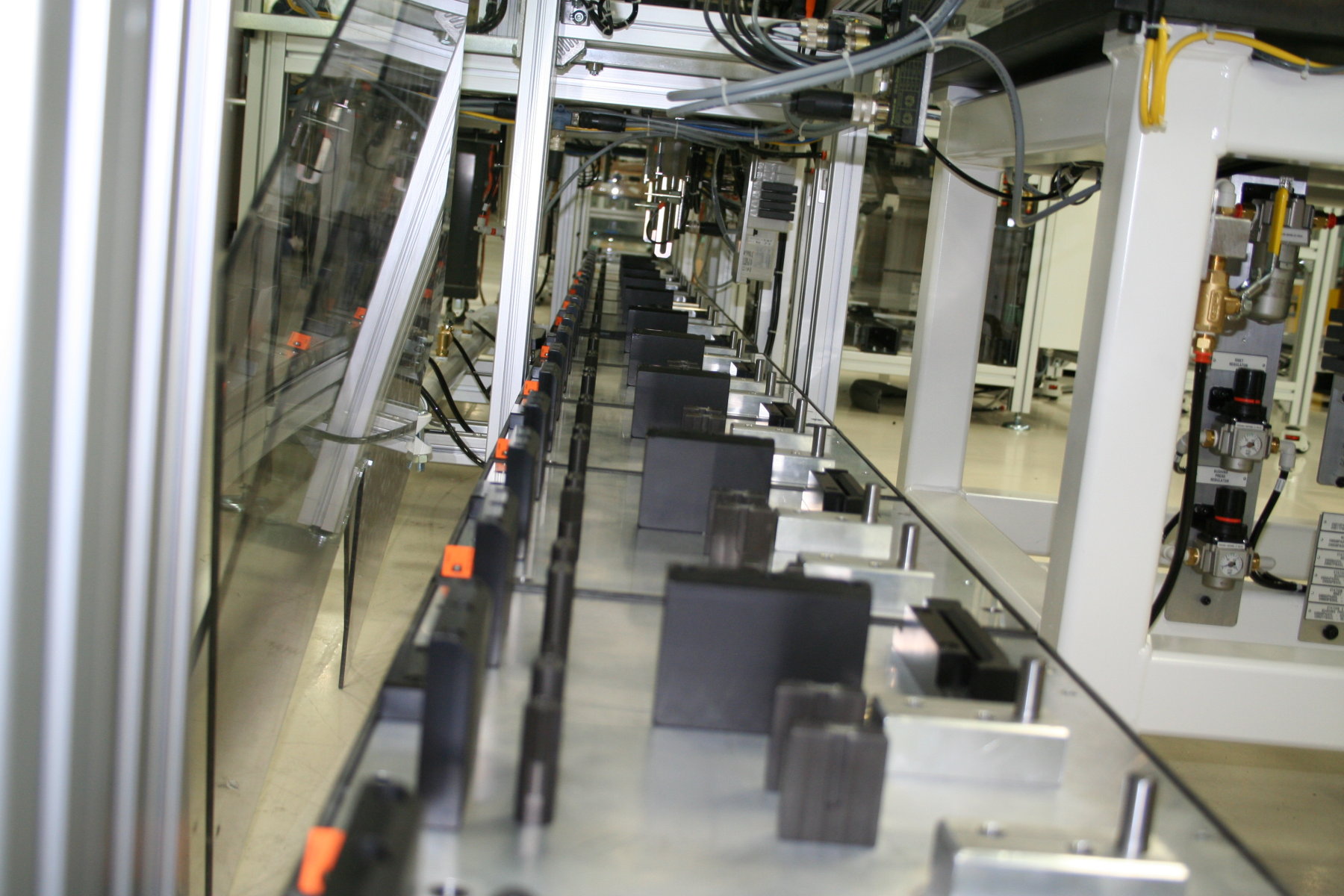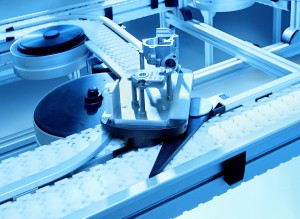Rick Blake, President
Edgewater Automation
In almost every facet of today’s world, from telecommunications to transportation, from tiny cell phones to construction vehicles, batteries are included. New advances in battery technology, particularly lithium ion and multi-cell prismatic designs, create new, unique challenges in automating battery assembly.
Battery production can truly be described as an industry in which the only constant is constant change: new designs, new production techniques, new automation approaches and radical changes in demand.
The challenge for assembly system designers, such as Edgewater Automation (www.edgewaterautomation.com), is to create specialized approaches for varying methods of stacking cells, connecting tabs, module packaging (gluing, banding, heat sealing) and much more, while also keeping in mind that the needs of today will not necessarily be the needs of tomorrow.
One of the best responses to this ever-changing environment has proven to be the use of conveyor technologies that make it easier to both create and alter assembly lines, allowing manufacturers to expand production, add more automation, create more balanced work flow to manage demand, and blend manual and automated assembly techniques as needed. Edgewater, for example, has found that the key elements in creating an effective modular approach to battery assembly include aluminum frame-based, precision conveyor systems. They provide the flexibility to create a wide variety of assembly solutions, particularly in assembling prismatic multi-cell battery modules.
Pallet-Based Flexible Assembly Conveyors

Many of the opportunities that Edgewater encounters today are the result of a dramatic need for changes in modern transportation methods. Cars, trucks, and buses all require large, heavy batteries that are assembled step-by-step from a wide range of components, some of which may be sensitive and require gentle handling. Steps may include cell stacking, tab joining, end-process testing, framing and casing and charging. To handle the diversity of assembly processes, Edgewater often turns to modular pallet-based assembly conveyors, such as Rexroth’s TSplus conveyors.
Modular pallet-based systems are the backbone of many of Edgewater’s battery assembly systems, because they increase line productivity while reducing the potential for damage to the product. Fixturing the product to the pallet makes it easier to control the assembly processes and to add components in a controlled manner. These conveyors offer a wide-range of options for routing, handling, and positioning the battery components, and cushioned stops are available for gentle components or processes.
Pallet-based modular conveyors also support recent initiatives to enhance control over the process further by using RFID tags to make unique data available throughout every step of the process through a bar code or 2-D code on the tags. The tag is placed on the pallet and exchanges information with scanning equipment at each workstation. This makes it easier for workstation operators and floor managers to track the flow of parts, subassemblies and finished products, even if parts are diverted to multiple or redundant workstations. Workers have real-time information about where each pallet is at any given time.
Blending Automated and Manual Operations
One of the biggest factors in increased control over battery assembly systems is the ability to combine manual and automated procedures on a single line. A line for building subassemblies (battery packs) can incorporate totally automated workstations for welding tabs as well as manual workstations where two parts are mounted using a screwdriver.
With its wide range of options for routing, handling and stopping parts, the modular conveyor approach lets us design an overall system that maximizes throughput and production flexibility. Typically, a central main conveyor system is used to circulate the battery as it’s assembled. From this main line, the battery can be routed onto “cycle-independent” spur lines on which automated or manual processes can occur (or both). The use of multiple, redundant workstations for some of the slower or more intricate processes helps to balance production across the entire system. For example, multiple tabs can be welded quickly at multiple workstations via cycle-independent conveyor loops that move subassemblies through the workstations, and then transfer them back onto the main line. Doing this prevents a slow process from interfering with the overall production cycle requirements. Additionally, cycle-independent loops like these could also accommodate a variety of different assembly approaches or handle multiple steps simultaneously. By using a “building block” approach to create an assembly area, it’s easier for battery manufacturers to step up production without overtaxing any of the workstations or risking damage to product.
Flexible Chain Conveyors Support Modular Assembly Concepts

In some assembly areas, delicate components, such as lithium ion wafers, may benefit from automated parts supply. In these circumstances, Edgewater often combines a modular chain conveyor system, such as Rexroth’s VarioFlow, to transfer components smoothly and consistently into automated assembly equipment (SCARA or 6-axis robots perform most assembly tasks). The conveyor and the all-robotic assembly processes are both controlled by dedicated hardware and software; VarioFlow capabilities are compatible with most standard motion control software systems as well as Rexroth’s own proprietary electric drive and control and HMI products.
Modular, flexible chain conveyor systems like VarioFlow typically offer a wide range of conveyor modules and components, so that automated parts-feeding and material handling enhancements can be added easily to a larger battery assembly system. This allows Edgewater to create reconfigurable systems that are optimized to the needs of each customer, and which help customers keep pace with changes in demand and in assembly techniques. Systems like VarioFlow are typically used for lighter-duty processes in battery assembly applications (e.g., individual lithium-ion cell components a few inches square) but they are capable of handling considerable weight and size, and offer high chain tensile strength (up to 1,250 N). These systems are also durable, speedy (up to 60 feet per minute in some applications) and able to handle sharp curve radii in both the horizontal and vertical plane to conserve valuable floor space. High-performance, variable-speed drives allow for maximum efficiency in operation and can save thousands of dollars in energy costs. The overall result is a parts delivery system that puts parts where they’re needed fast in the most efficient possible manner.
Keeping Up with the Future
Perhaps the biggest advantage of the modular assembly line approach to battery production, however, lies not just in keeping up with what is happening today, but in the ability of manufacturers to anticipate the needs of tomorrow. Environmental regulations, consumer demand, changes and innovations in battery fabrication techniques, and in batteries themselves, call for innovations that go beyond traditional assembly processes. In the world of hybrid and electric vehicles, for example, lack of manufacturing agility could make it difficult to remain competitive if new and better battery technologies emerge. Modular assembly systems make it easy to adapt to these changes, even if the pace of change is dramatic, as it is in the lithium ion arena. Because of their built-in flexibility, these conveyors inspire innovation rather than limit it: Battery manufacturers using modular technologies know that they can re-configure, add to or expand their system to handle whatever advances they can dream up, without having to scrap the entire system and start over from scratch.
The modular approach helps manufacturers respond to change with nimbler, leaner manufacturing processes. That reduces the cost of ownership by minimizing the cost of change, and provides a solid foundation for growth. Experience has shown that modular assembly solutions can be rapidly expanded to large sizes, even where space is limited, because designers have the flexibility to add conveyors and workstations in a variety of physical orientations and configurations. It should be noted that the process of expansion or reconfiguration also depends on rapid access to components such as VarioFlow or TS conveyors and workstation aluminum framing.
The modular approach to battery assembly systems is paying off for a number of manufacturers producing a wide range of battery products. Not just because their assembly lines are providing top-quality materials handling and throughput now, but because modular capabilities ensure that these manufacturers are ready for the future. When changes in technology or in the marketplace occur, the ability to reconfigure or expand quickly can reduce time to market, cut costs and give battery producers a competitive edge.
Rick Blake is the founder and President of Edgewater Automation, a company that specializes in designing and building custom automation for the automotive, robotic, electronic, stored power, and military industries. Blake founded the firm in 2001 and is today leading Edgewater Automation in expanding their capabilities in the pharmaceutical, medical and solar markets.
For more information, please contact Edgewater Automation at Rick.blake@edgewaterautomation.com or www.edgewaterautomation.com.







